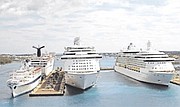Friday, February 26, 2021
By NEIL HARTNELL
Tribune Business Editor
nhartnell@tribunemedia.net
The Downtown Nassau Partnership’s (DNP) co-chair yesterday said he was “not as negative” as senior Carnival executives on the city’s prospects although he agreed “there’s room for improvement”.
Charles Klonaris told Tribune Business he “does not totally agree” with Giora Israel, Carnival Group’s senior vice-president for port and destination development, who lamented the lack of new and exciting activities for passengers to do in Nassau pre-COVID-19.
Echoing Michael Maura, Nassau Cruise Port’s chief executive, the DNP chief said downtown Nassau and Bay Street stakeholders were “taking the long-term approach” to improving the city and its attractiveness to both locals and visitors.
Suggesting that the $268m Prince George Wharf transformation was the first step towards sparking the area’s overhaul, Mr Klonaris said: “I don’t totally disagree with what he’s saying; there’s room for huge improvement downtown.
“We’ve been hearing these criticisms for a long time but I feel very positive. You take excursions like Dolphin Encounters, Blue Lagoon, the excursion to Exuma to see the swimming pigs, those are huge and popular excursions. There’s room for improvement for sure, and there could be improvements in cleanliness and behaviour short-term, but we’ve taken the long-term approach.”
Mr Klonaris admitted that downtown Nassau’s retail offering was “a weak point of the city” beyond upscale outlets such as John Bull and Gucci, and argued that there needed to be greater diversification and an infusion of authentically Bahamian products to improve a shopping mix that remains too reliant on t-shirt and souvenir stores.
Restaurants that catered to both locals and tourists were also required in greater number, he added, along with the likes of coffee shops and ice cream parlours. “That’s a missing element of the city of Nassau,” Mr Klonaris told Tribune Business. “Retail is a missing part of the product to make the city itself more attractive.
“It’s a long haul but I’m very optimistic about what’s taking place. I don’t look at it as negatively as Mr Israel claims to be.” He pointed to the soon-to-be-completed Pointe project next to the British Colonial Hilton, as well as the ongoing work at the US Embassy and construction of the new Central Bank as projects that will all help to uplift downtown Nassau once finished.
Pointing out that The Bahamas’ relationship with the cruise lines was a “two-way street”, and that Carnival “has benefited immensely from what we’ve given them” in terms of private islands and multiple destinations in this country, Mr Klonaris said the city’s 11 months-and-counting COVID-19 shutdown had “opened the eyes” to the dangers of relying on a “one dimensional economy” driven by the cruise lines.
Mr Israel had earlier this week told Tribune Business the Bahamian capital must do far more to overhaul its “product” post-pandemic as the identity of its most popular tour, visits to locals hotels and their amenities, “tells you a lot”.
While praising the private-public partnership (PPP) with Global Ports Holding for Prince George Wharf’s $268m transformation, Mr Israel said he and other Carnival executives had repeatedly urged the government to constantly refresh Nassau’s attractions, excursions and tours offering if it was to rebuild its reputation as a leading tourism destination.
He explained that this was especially important as many of the passengers on Carnival’s three, four and five-night cruises through The Bahamas were repeat customers who had visited the city before, and therefore needed new and exciting activities to entice them off the ship.
“I think that the maritime improvements that are being done, adding strength to one of the piers and expanding another, are welcome,” Mr Israel told this newspaper of Nassau cruise port upgrades. “Enhancing the arrivals experience is welcome as well. We are encouraged these things are being done.
“One of the issues we’ve stated to the Bahamian government is what Nassau needs more than the maritime facilities is the enhancement of the destination for activities,” Mr Israel said. “Over the years there has been very little product to offer people coming again and again.
“It’s not the port itself, it’s the product; the availability of” new attractions and excursions for passengers on short-haul cruises who have visited Nassau before on previous trips. In the absence of new and upgraded products, Mr Israel added: “Prior to COVID-19, we were only able to sell 26 percent to 28 percent of passengers a tour.”
This, he added, meant that only 700-800 passengers on a 3,000-person cruise ship went on a tour or excursion, limiting the income and revenue earned by the Bahamian-owned tourism operators that typically populate this space.
“Some don’t get off the ship,” the Carnival executive added, as some perceived there was little to do in Nassau beyond shopping while others went off on their own sight-seeing.
“What a great destination needs, and it is true anywhere in the world, is that people come to a destination wanting things to do, tours and so on,” Mr Israel said. “There are some ports in the Caribbean that reinvent themselves and add new attractions.”
Emphasising that he spoke from personal experience, having spent four years in The Bahamas while developing the Coral World attraction that launched in 1984, he reiterated: “There’s very little product for hotel guests, tourists, and the fact the number one tour in The Bahamas is to go to the amenities of a hotel tells you a lot.”
Atlantis, in particular, developed a significant revenue stream from cruise passengers visiting its water park and other facilities on day passes prior to COVID-19. That will likely rebound once the cruise industry resumes sailing again, although such income may have to be split with Baha Mar once its $200m Baha Bay facility comes online this summer.
